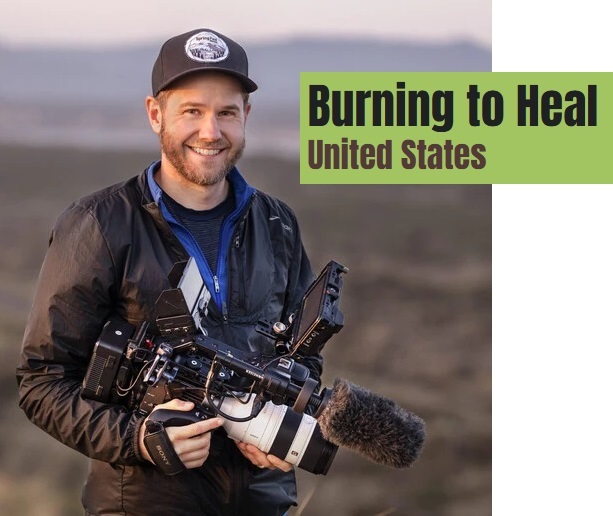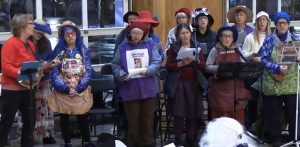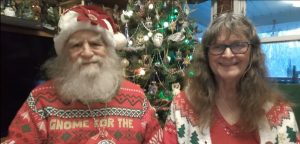EEFF film celebrates human use of fire: ‘We are who we are because of fire’
7 min read
Curtis Blankinship (KEPW News): Michael Sherman, the filmmaker of Burning to Heal, led a panel discussion about prescribed burning at the Eugene Environmental Film Festival.
[00:00:12] Prescribed Burn Associations, or PBAs, bring together landowners, volunteers, and trained fire professionals to put good fire on the land. The Rogue Valley Prescribed Burn Association fosters community safety and preparedness, ecological land stewardship, and resilient ecosystems by educating and training community members in the use of prescribed burning to implement prescribed burning on their own land.
[00:00:37] Aaron Krakava is the Prescribed Burn Program Director for the Applegate Partnership and Watershed Council in Southern Oregon, and the Rogue Valley Prescribed Burn Association Steering Committee chair.
[00:00:51] Aaron Krakava (Applegate Partnership and Watershed Council): Really the thing that struck me the most was how much support there actually was.
[00:00:57] You know, our first burn then was in spring of 2021, which was just six or seven months after the Almeda fire, after the Labor Day fires. There was a lot of worry, a lot of fear, a lot of concern, like, what was the response to this going to be? And actually, I found that the community was at peace, by and large really, really supportive and interested.
[00:01:15] I think it kind of clued people into this that like the status quo isn’t working. Like, whatever we’ve been doing so far is not making things better, it’s just leading to more destructive wildfire, more destruction of communities.
[00:01:25] And giving this possibility of a prescribed burn association where individuals, community members can actually work together on their own and actually become involved in protecting their community, becoming more involved with fire, having a better understanding and relationship with fire.
We had folks come out who had been evacuated in the Almeda Fire and had a lot of trauma around fire. But being able to come out to these burns and see fire as a tool that can be used and can be a part of our life and can be actually beneficial was really helpful for them.
[00:01:58] And so, yeah, overall it was a lot of work and pain, but the response was really just overwhelming and showed how much interest there was in it. The fire departments have been overwhelmingly supportive. Like, I think we’ve had eight or nine different fire departments now participate in our burns. Almost every phone call I make is always a, ‘Yes, what can we help with? Where can we go? What do you want us to do?’
[00:02:21] Curtis Blankinship (KEPW News): Amanda Rau is the regional fire specialist for Oregon State University Forestry and Natural Resources Extension Fire Program, and chairwoman of the Oregon Prescribed Fire Council.
[00:02:32] Amanda Rau (OSU Forestry and Natural Resources Extension Fire Program): Going to the PBA burns over the last two years has been a real big change for me, because I come from a history of suppression fire moving into prescribed fire.
[00:02:42] So I’m mostly noted for my prescribed fire work. But I have a foundation of suppression. And a lot of things get ingrained into you in that world. So when you end up on these PBA burns, it’s community-based, there’s children, it’s a totally different model of doing things. And I have been changed as a practitioner by this.
[00:03:01] It’s amazing. And it’s so important that the community knows this is happening because it’s a reduced barrier to entry for getting to experience fire, getting to work with fire. And that’s what we all need if we’re going to face the future that is coming, that’s already here, and that is coming, is that everybody needs to understand how fire works.
[00:03:18] It runs through our communities, it runs through our wildlands, it doesn’t matter. Everything’s built to burn on this earth. And so, when we are able to take that back into our own hands, we have control over something again. And we, our fear is brought back down to a realistic level, because fire inherently is not a scary thing.
[00:03:36] Fire out of control, doing things we don’t want it to do, that can be a scary thing, but as an element, it is not. And we’ve been trained away from that, and so, you know, getting back to the homeland here. You know, my ancestors encountered a place that was fairly departed, because people had been impacted by disease, and the fire on the landscape followed that.
[00:04:00] So they didn’t really see what I envisioned as the work of getting fire back on these lands. I rely on people like Drew, and I rely on history and General Land Office surveys, and imagination of ‘What was this like?’ Paintings of the first people that came here from the west, you know, or to the west from the east.
[00:04:23] You know, that’s how we kind of account for what it, what is this built for. But now what it really amounts to is climate change, adapting to that, and really being on top of things, because we need, we need to maintain this landscape with fire. It is extremely productive, and it was built to burn. And I can say that about a lot of Oregon, but it, particularly the bottom of the Willamette Valley, it has a window that starts in about July.
[00:04:50] Presenter: It continues through October. Amanda Rau:
[00:04:52] Amanda Rau (OSU Forestry and Natural Resources Extension Fire Program): You know, it’s just remarkable to me the degree to which we have excluded fire from the Lane County landscape. And we have a lot of power about how to put that back. Now we have a precedent set, which is West Eugene Wetlands / Rivers to Ridges partnership.
[00:05:07] And work that’s been done by a lot of partners, including Eco Studies Institute, the Nature Conservancy, Oregon State University is a part of this, a whole bunch of different partners here in the Willamette Valley, and especially the South Willamette Valley have come together. They’ve been already doing this work for a long time.
[00:05:25] So I want to be clear, 30 years of ecological burning have been happening in the South Willamette Valley. What hasn’t been happening is doors open to those who are not qualified, trained, and vetted through the fire suppression-industrial complex, essentially, which I’m a part of. I work for the state, okay?
[00:05:42] And we have a mandate to put fires out, and we’re going to keep doing that. We’re not stopping that. But what we are doing at the same time is opening the door to prescribed burning, hopefully at the same scale as firefighting.
[00:05:53] I guess what I’m trying to get at is that if all citizens can’t get involved, or at least most, we’re not—this isn’t going to work. Because we cannot rely on firefighters to save us and we can’t even rely on these partnerships of nonprofits to do it.
[00:06:07] We’ve got to get more people involved in that.
[00:06:08] Curtis Blankinship (KEPW News): Chris Adlam is fire specialist with the Oregon State University Extension’s Fire program.
[00:06:17] Chris Adlam (OSU): When we talk about prescribed fire, we often talk about, we’re bringing fire back to the landscape. We talk about it in ecological terms. We’re putting fire back on the land. But, you know, what we’re doing here, too, is bringing fire back to people.
[00:06:29] That is, fire is a social process. It’s a cultural process as well. It’s how we build meaning with each other in our communities and that connection with the landscape and that’s just as important. I think it’s a bit of a shift when we start seeing it that way. It’s just a fundamental part of so many cultures around the world.
[00:06:48] We’re in such a unique, in a unique time where we’re so cut off from fire. It’s just a very strange thing for our species, which for hundreds of thousands of years has been using fire on the landscape. We are who we are because of our use of fire. Like, physically, genetically, our species is intricately tied to its history with fire, and yet most people have no experience with fire today.
[00:07:14] Imagine growing up with no experience with water, or air, or earth. We all know what water does, right? It goes downhill. We know what it feels like to hold earth in our hands and what mud is like and the, the wind. And yet, you know, with fire, we often have no experience, other than maybe a campfire.
[00:07:36] And that’s just a strange thing. And that leads us to having these fears and casting fire as this destructive thing that we try to get rid of. And the more we try to get rid of it, the worse the problem gets. And so, yeah, I think that reintroducing fire to people and to cultures and to communities is super important.
[00:07:57] And it’s going to take a long time. It’s going to take generations. It’s taken us generations to get to where we are now, and it’s going to take us generations to make this kind of change again.
[00:08:06] Curtis Blankinship (KEPW News): For more information on prescribed burning go to RogueValleyPBA.com. For more on the Eugene Environmental Film Festival go to EugeneEnvironmentalFilmFestival.org. For KEPW News, I’m Curtis Blankinship.





